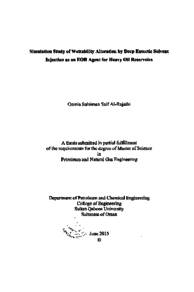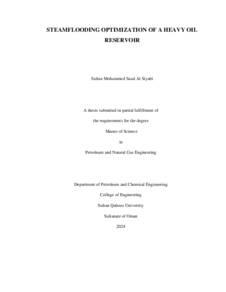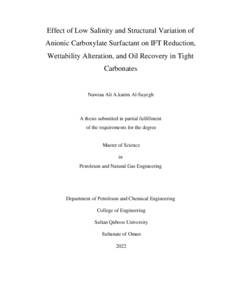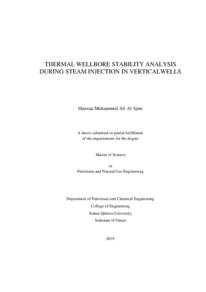Document
Simulation study of wettability alteration by deep eutectic solvent injection as an EOR agent for heavy oil reservoirs
Publisher
Sultan Qaboos University
Gregorian
2015
Language
English
English abstract
Several oil fields in the world have already recovered the easy-to-produce oil and are now in the depletion period. Such fields need enhanced oil recovery (EOR) methods implementation to improve the recovery factor and maintain oil production rates economically. Deep Eutectic Solvents (DESs) are alternative classes of lonic Liquids (ILS) which have been investigated as novel solvents for the chemical EOR. In this study, simulation of enhancing heavy oil recovery via Deep Eutectic Solvent injection was conducted. Several coreflooding tests have been completed and modeled to study the effect of DES injection on the interactions of oil/brine/rock in the porous media. The performance of the Choline Chloride: Malonic acid mixture at two molar ratios (1:1) as DES1 and (1:0.5) as DES2 were studied at different temperatures. DES injection affected wettability and relative permeability of the fluids and enhanced the recovery of the oil. By applying the models to a pilot scale reservoir, for different scenarios, the DES injection approach as the tertiary recovery method was investigated and optimized. Different parameters such as DES injection rate, injection pore volumes, well patterns, and injection scenarios had been optimized for each case. Our results indicated that the wettability alteration from weakly water wet towards more water wet and mixed wet conditions was the dominant factor for the reduction of residual heavy oil saturation. DESs injection resulted in favourable and lower mobility ratio compared to the conventional waterflooding. At 45 °C, mobility ratio reduced by 26% in DES1 and 25.5% in DES2 compared to the waterflooding. With increasing the temperature to 80 °C, mobility ratio reduced by 84.8% in DES1 and 62.2% in DES2. Hence, temperature found to be a key parameter to improve the performance of DESs injection to modify the oil/brine/rock interactions. Furthermore, early breakthrough was observed to be less in DESs injection which improved the sweep efficiency. Our study showed that DESs display better performance as a tertiary recovery rather than the secondary. For 30 years injection, tertiary stage (waterflooding 20 years/DESS 10 years) increased the recovery by DES1 injection for 2-5% compared to the secondary injection. In addition, our screening study showed that DESI worked better at lower reservoir temperature (about 45 °C) while DES2 was more active at higher reservoir temperature (>60°C) in both secondary and tertiary recovery methods. Our experimental and simulation studies showed the possibility of the application of DESs as cheap, non-toxic, recyclable, biodegradable and environmentally friendly chemicals for the EOR field applications. DESs injection methods are considered beneficial to enhance oil recovery due to their abilities to alter oil/water/rock interaction to more favourable condition, reduce mobility ratio, and improve the sweep efficiency at different heavy oil reservoir conditions.
Description
Thesis
Member of
Resource URL
Arabic abstract
استنزفت العديد من حقول النفط في العالم النفط سهل الإستخراج. مثل هذه الحقول قد تحتاج الى طرق تعزيز استخراج النفط لتحسين الاستخلاص و الحفاظ على معدلات انتاج النفط اقتصاديا احدى هذه الطرق هي استخدام المذيبات ذات درجات الانصهار المنخفضة (Deep Eutectic Solvents) والتي تعد بديلا للسوائل الأيونية (Ionic Liquids) . هذا البحث تطرق لدراسة محاكاة تعزيز استخراج النفط الثقيل عن طريق الحقن بالمنيبات ذات درجات الانصهار المنخفضة وتأثير هذه المذيبات على خصائص التفاعل بين الصخور والسوائل. اجريت العديد من الحراسات في المختبر المعرفة فعالية وتأثير الحقن بالمغيبات ذات درجات الانصهار المنخفضة على خصائص التفاعل بين الصخور و السوائل بدرجات حرارة مختلفة، حيث تم استخدام محلول ( Choline - Chloride : Malonic Acidبنسب مولية 1 : 1 (كمحلول 1 و10 , 5 كمحلول2. حقن هذه المذيبات أثرت على خاصية التصاق السوائل بالصخور والنفاذية وعززت انتاج النفط. هذا البحث تطرق لمحاكاة خصائص الصخور والسوائل عن طريق تطبيق نتائج البحوث التي أجريت في المختبر على نموذج حاسوبي لمكمن نفط ثقيل. تم اختبار سيناريوهات مختلفة من طرق الحقن المعززة للحصول على الانتاج الأمثل مثل معايير ومعدلات الضخ، معدلات حقن كميات المسام و أنماط حفر آبار مختلفة وسيناريوهات حقن أخرى. أشارت نتائج هذه الدراسة أن تغير خاصية التصاق السوائل بالصخور من التصاق ضعيف بالماء الى التصاق قوي بالماء والتصاق مختلط بين الماء والنفط هو العامل الأساسي و المهيمن الذي أدى لإنتاج واستخلاص النفط الثقيل الملتصق بالصخور. بمقارنة نسبة التنقل وحركة الماء الى حركة النفط، تبين أن النسبة تقل بعد ضخ المذيبات ذات درجات الانصهار المنخفضة واللي تعني زيادة فعالية الانتاج بضخ هذا المحلول. مثلا عند درجة حرارة 45 مس، قلت نسبة التنقل بين الماء مقارنة بالنفط بنسبة 26% للمحلول الأول و 25 , 5 % للمحلول الثاني. بزيادة درجة الحرارة الى 80 °س، قلت نسبة التنقل بين الماء مقارنة بالنفط بنسبة.884 % للمحلول الأول و % 62 , 2 للمحلول الثاني. وبناء على ذلك، اعتبرت درجة الحرارة عاملا رئيسيا أدي لتحسين أداء الانتاج وتعديل التفاعلات بين النفط الماء الصخور. علاوة على ذلای، لوحظ نقصان في خاصية الإحتياع والإنتاج المبكر بواسطة حقن المذيبات ذات درجات الانصهار المنخفضة مقارنة بضخ الماء والتي تدل على زيادة كفاءة الاجتياح العياني والمجهري للنفطي أظهرت الدراسة أيضا أن أداء هذا المحلول كمرحلة حقن معززة (20 سنة حقن بالماء ثم 10 سنوات حقن بالمذيب) أفضل من أدائه كمرحلة حقن ثانوية (حقن بالماء فقط) بزيادة مقدارها 2-5% في الانتاج بمقارنة الحقن لمدة 30 عاما. بالإضافة إلى ذلك، أظهرت نتائج فحص أداء المذيب في مراحل الانتاج المعززة والثانوية أن أداء المحلول الأول أفضل عند الضخ في محيط يتسم بدرجة حرارة منخفضة (45 °س) بينما أداء المحلول الثاني أفضل عند درجة حرارة مرتفعة (أكبر من 60 °س. بينت دراستنا التجريبية و المحاكاة إمكانية تطبيق استخدام المذيبات ذات درجات الانصهار المنخفضة كمعزز لاستخراج وانتاج النفط الثقيل نظرا لسعره المنخفض و اعتباره مادة غير سامة، قابلة للتحلل وإعادة التدوير و صديقة للبيئة. وتعتبر طرق الحقن بهذا المذيب مفيدة لتعزيز استخراج النفط بسبب قدرتها على تغير التفاعل بين الماء النفط الصخور الى حالة أكثر ملائمة، تقليل نسبة التنقل للماء مقارنة بالنفط و تحسين كفاءة الاجتياح في مختلف ظروف مكمن النفط الثقيل.
Category
Theses and Dissertations







